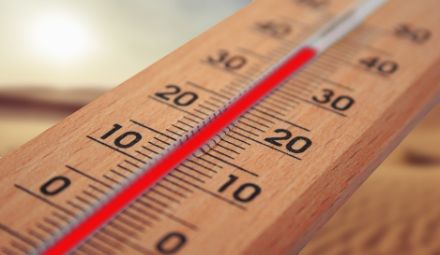Service Navigation
Search

In large parts of the world, as well as in Switzerland, heat stress has increased dramatically in recent years due to climate change. Hot spells, when high temperatures last for several days, will increase in frequency and intensity in the future. In Switzerland, hot spells are normally associated with stable high-pressure conditions in the summer months.
Increasingly intense hot spells
Basel is one example of how hot spells are becoming more frequent and intense. The mean temperature of the most intense three-day hot spells has increased by 2–2.5 °C over recent decades. The longest consecutive periods with mean temperatures above 25 °C are now more common and last several days longer than in earlier times.
The temperature threshold of 30 °C is relevant when it comes to climatological analyses. If this threshold is reached or exceeded on one day, it is considered a hot day. This term is also used in weather forecasts.
According to the Swiss climate change scenarios CH2025, Switzerland will face further increases in the frequency and intensity of hot spells due to continuing climate warming.
With continued climate warming, an increase in heat stress and associated negative consequences for humans and society can also be expected. Studies show, for example, that heat stress could become a problem in central and northern Europe, particularly for those working in the blazing sun. This will lead to a drop in summer productivity in Switzerland of around 25%.
Heat in cities
In certain weather conditions and seasons, and at certain times of the day, cities have systematically higher temperatures than surrounding rural areas. The temperature differences between rural and urban areas are particularly pronounced at night. This so-called “urban heat island” effect occurs because the local climate in cities differs substantially from that of less built-up regions due to dense development, human-induced emissions, waste heat and less vegetation and ventilation. Because building materials store heat very effectively, cities heat up more during the day and cool down more slowly at night than surrounding rural areas.
A significant health hazard
Hot spells put the human body under extreme stress, and can be a severe health hazard. For example, they can result in cardiovascular and respiratory diseases and impair mental and physical performance. Heat can even cause death: In the summer of 2003, there were 975 excess deaths in Switzerland due to heat, according to a study conducted by the NCCS, the National Centre for Climate Services. Across the whole of Europe, 2003 saw around 70,000 premature deaths.
The Federal Office for Civil Protection rates heat waves as one of the biggest natural-hazard threats to Switzerland. It is not only high daytime temperatures that affect human health, but also high temperatures at night. Without sufficiently cool nights, the body struggles to recover, meaning that it also has less ability to cope with daytime heat stress.
MeteoSwiss has been issuing heat warnings since 2005, and continues to develop and refine its warning system. The aim of the warnings is to allow the population and authorities to prepare effectively and in good time for an impending hot spell.